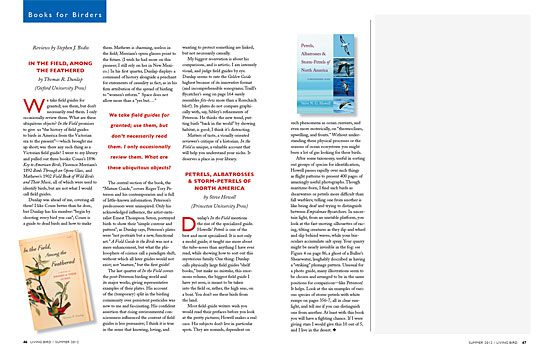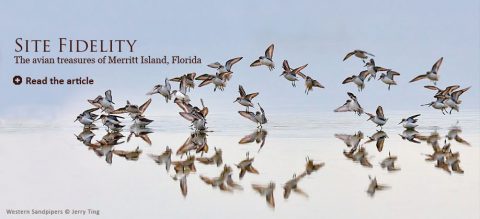Book Review: In the Field, Among the Feathered by Thomas R. Dunlap
Reviewed by Stephen J. Bodio
July 15, 2012
We take field guides for granted; use them, but don’t necessarily read them. I only occasionally review them. What are these ubiquitous objects? In the Field promises to give us “the history of field guides to birds in America from the Victorian era to the present”—which brought me up short; was there any such thing as a Victorian field guide? I went to my library and pulled out three books: Coues’s 1896 Key to American Birds, Florence Merriam’s 1892Birds Through an Opera Glass, and Mathews’s 1902 Field Book of Wild Birds and Their Music, all of which were used to identify birds, but are not what I would call field guides.
Dunlap was ahead of me, covering all three! I like Coues better than he does, but Dunlap has his number: “begin by shooting every bird you can”; Coues is a guide to dead birds and how to make them. Mathews is charming, useless in the field; Merriam’s opera glasses point to the future. (I wish he had more on this pioneer; I still rely on her in New Mexico.) In his first quarter, Dunlap displays a command of history alongside a penchant for statements of causality as fact, as in his firm attribution of the spread of birding to “women’s reform.” Space does not allow more than a “yes but.…”
The central section of the book, the “Mature Guide,” covers Roger Tory Peterson and his contemporaries and is full of little-known information. Peterson’s predecessors were uninspired. Only his acknowledged influence, the artist-naturalist Ernest Thompson Seton, portrayed birds to show their “simple contour and pattern”; as Dunlap says, Peterson’s plates were “not portraits but a new, functional art.” A Field Guide to the Birds was not a mere enhancement, but what the philosophers of science call a paradigm shift, without which all later guides would not exist; not “mature,” but the first guide!
The last quarter of In the Field covers the post-Peterson birding world and its major works, giving representative examples of their plates. His account of the (temporary) split in the birding community over persistent pesticides was new to me and fascinating. His confident assertion that rising environmental consciousness influenced the content of field guides is less persuasive; I think it is true in the sense that knowing, loving, and wanting to protect something are linked, but not necessarily causally.
My biggest reservation is about his comparisons, and is artistic. I am intensely visual, and judge field guides by eye. Dunlap seems to rate the Golden Guidehighest because of its innovative format (and incomprehensible sonograms; Traill’s flycatcher’s song on page 164 surely resembles fitz-bew more than a Rorschach blot!). Its plates do not compare graphically with, say, Sibley’s refinements of Peterson. He thinks the new trend, putting birds “back in the world” by showing habitat, is good; I think it’s distracting.
Matters of taste, a visually oriented reviewer’s critique of a historian. In the Field is unique, a valuable account that will help you understand your niche. It deserves a place in your library.

All About Birds
is a free resource
Available for everyone,
funded by donors like you
American Kestrel by Blair Dudeck / Macaulay Library



